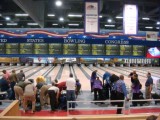 Team Bowl4Money.com #1 – Our Story and our Success at the 2013 USBC Open Championships:
Team Bowl4Money.com #1 – Our Story and our Success at the 2013 USBC Open Championships:
By Derek Petty
Our five bowlers, all recognized and respected bowlers in the Nation’s Capital Area Bowling Association (DC, MD, VA), have been competing together since 2004 and continue to improve as individuals and as a team as we compete in numerous local and national tournaments. (You can check us out here www.bowl4money.com) We have certainly had our fair share of ups and downs, but as a team, one of our best assets is the confidence and belief that each of us have in one another. We have yet to break the Top 25 at the USBC Open Championships, yet have eight Top 100 Finishes, and I believe it will happen soon.
Our companion team joined us in 2007 and it’s been five years running that the ten of us (less a few changes from our companion team) have teamed up. It has taken time for our two teams, but having all ten guys working to break down the lanes and play the lanes correctly is of the utmost importance to success at the USBC Open Championships.
This year we did things a bit differently – we hung out more as a group, and competed together in more of the side events (BJ, BTM, 40 Frame Game, 900 Global Events). In preparation for the USBC Open Championships, we also bowl league together and compete in local tournaments. Matt McNeil and Jeff Richgels have also preached this type of camaraderie to familiarize yourself with equipment, make game improvements and get the tournament atmosphere in your mind. Bowling league is different than bowling in a tournament; it’s different for your mind, it’s different for your nerves, it’s a different atmosphere, and for those of us traveling from the East Coast the Open Championships is a completely different time zone.
Our team bowled well in the side events this year. We didn’t take the lead in any of them, but we will get some prize money back and more importantly we got much needed information and practice in this “different” atmosphere and venue. This year, as we do every year, we did our fair share of watching videos (Thank you Matt C. and crew) and listening to podcasts (tburg.wpengine.com) and many of us had a session at Lane 81 with Mike Jasnau, all of which provided valued and advanced information to this once a year event. With all of the advanced research we had done, we determined the following information for equipment:
- Balls with low RG’s (.050 ish)
- Balls with lower Differentials (.050 or less)
- Ball surfaces for Team event 1000 & 2000 Abralon (dry sanded)
- Ball surfaces for Minors 2000 & 4000
- Our reason, we wanted balls that roll through the pattern, not ones that produced abrupt right or left angles upon exiting the pattern.
The rev rates and speed of our ten players is quite similar. We have a few anomalies, but everyone is able to play the same part/area of the lane. Between the two teams, our rev rates and speeds match, which allows making moves and transition more predictable as a group.
– Bowl4money.com #1
- Two with rev rates of 250 – 320
- Three with rev rates of 300 – 360
- Ball Speeds of 17 – 19 mph
– Bowl4money.com #2 (Our companion team)
- Three with rev rates of 250 – 320
- One with a rev rate of 280 – 330
- One with a rev rate of 330 – 400, yet a higher ball speed as well
- Ball Speeds of 15 – 19 mph
Our Team Event Plan (7pm : 5/13/13 : Lanes 29 – 30)
– Practice – Throw a few shots (3 to 4 per person) up 6 – 7 – 8 then work to get lined up.
– Game 1 – we played near the track (13 – 10) to (8 – 6). As the lanes transitioned, which was minimal game 1, we gradually moved in. No one was left of 15 at the end of Game 1.
– Game 2 – Lane 30 started to hook more in the mids than 29, thus we chased it in a bit more, but were very cautious to keep the angles down and play more direct. By the end of game both lanes had transitioned back to nearly the same and we were all closer to 15 at the arrows and 10 down lane.
– Game 3 – We had a quick team huddle before we started game 3 as we did not have a great team 9th and 10th frame (game 2). We made a decision that everyone should be around 15. We had success at the beginning of the game through the middle, I even started with the front 7 which was slowed by a 7-10 in the 8th. Transition was still minimal, though we did start migrating half boards and boards with our feet, and boards on the lanes nearly every shot from the third frame on. The deepest we got was 20 to 12-10 by the end of game 3.
Synopsis:
Some of our players needed 500 to 1000 to start Team event and could have switched to 1000 for the entire event. Many started with 2000 on their equipment and it created a lack of grip in the fronts and mids as their balls were unable to slow down. The transition was predictable and by Game 3 the shot became easier than a house shot – with regards to ball reaction and hitting the pocket.
Bowl4money.com #1:
Game 1: 1042
Game 2: 1062
Game 3: 1140
Minors (5/14/13 : 11am & 10:30pm : multiple pairs)
Four of our five guys bowled the 11am squad on lanes 51 – 52, and were paired with two very pleasant gentlemen from Montana. Thankfully one was left handed and the other agreed to break the lanes down with us. In the future, we will have six Bowl4money.com players on our minors pair.
Two of our other groups ended up with a random pairing during their minors event (Lanes 1 & 2 to boot), which was unfortunate, and created some unique transition and breakdown for them. The information below is representative of what the Bowl4money.com #1 and Bowl4money.com #2 players saw and experienced during their Minors event.
– Practice – Throw as many shots as possible up 3 – 4 – 5 with 4000 and stay there as long as possible. We all started with pin down layout equipment.
– Game 1 – we played up 5 – 6 for about 4 to 5 frames. If we threw it good, it struck, if we threw it bad, it was an unknown. After 4 to 5 frames, the comfort level of the guys on the pair grew thin as strikes were hard to come by. In agreement, everyone moved left and played the track area 10 to 6 – 7. We found success hitting the pocket, yet carry was an issue.
– Game 2 – We continued to chase the lane and transition – playing near the track (13 – 10) to (8 – 6). Mediocre games for all with costly splits for many throughout the game.
– Game 3 – As with many of the lanes at the stadium, the right lanes seem to hook earlier and more than the left. We continued to chase the transition and we were all closer to 15 at the arrows and 10 down lane. We started to notice the fronts burning up and carrydown/hold developing in a large fashion down the lane. We felt nothing but positive things could happen from here going forward.
– Game 4 – Many made ball changes to pin up 4000 or 2000 surface balls at the start of singles. Everyone was playing between 20 – 15 to 10 – 8 down lane. Our scores increased exponentially with the hold that had been created down lane.
– Game 5 & 6: Transition was smaller and became minimal as hitting the pocket became easier. Repeat shots and strikes were a flurry. We did start migrating half boards and boards with our feet, and boards on the lanes nearly every shot from the first frame of Game 5. The deepest we got was 22 to 13-10 by the end of game 6.
Synopsis:
Stay as far right as possible in practice and during game 1. We bailed on our game play to ‘stay right’ to fast – or in contrast, we did it long enough, about 10 shots a piece, and didn’t ball down fast enough during Game 1/2. Surface, as usual was the key. We all started with 2000 and 4000 surfaces, mainly pin down layouts to control ball reaction down lane and transitioned to Pin up balls during Game 3/4. Once the lanes transitioned in Game 3 & 4 and the hold was created down lane – it was game on.
2013 USBC OPEN Championships Conclusion:
Having read and listened to multiple resources about the Open Championships, all have been reliable with regards to ball layouts, ball surfaces and the balls to use. Execution and following the transition are the keys to high scores. Reading the mid-lane ball reaction and allowing the ball to roll through the pins created a lot of strikes. All parties that got their ball rolling BEFORE the first tracer board down the lane had tons of success (this is also evident in many of the USBC videos).
The formula of subtract 31 from the pattern distance holds true for both of these patterns. Each individual’s games will determine how you get there (speed, revolutions, ball roll), but you have to be confident when moves are required to move zones and arrows, not simply boards at a time. High and low rev rate players are able to start in the same area of play. There is no need to groove or burn a shot in during Team event – simply have fun and bowl great. In minors it is encouraged that everyone plays outside as long as possible to build up the shot and the hold for the pattern. Multiple teams have tried different techniques to break the lanes down, some were successful and some were not. Everyone’s talent level, rev rates, speed and desired ball reaction effects your lane transition, so pay attention to your ball and your game and transition as appropriate.
Remember to stay in the moment – one shot at a time – and have fun.



Derek, I knew you enjoyed bowling, but had no idea how much of a competitive bowler you have become! I read most of your article, until it became more technical writing and my eyes just glazed over!
Ask me about bikepacking sometime! 🙂
Go get the big win!
Well put and we will continue to get better as the years go on. But we are getting very close to breaking that top 25.